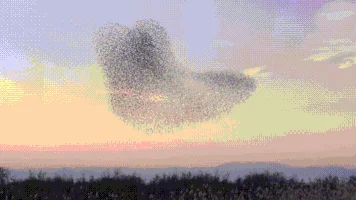Birds
of a feather flock together, but how do they decide where to go?
American
Institute of Physics
 Coordinated
behavior is common in a variety of biological systems, such as insect swarms,
fish schools and bacterial colonies.
Coordinated
behavior is common in a variety of biological systems, such as insect swarms,
fish schools and bacterial colonies. But the way information is spread and decisions are made in such systems is difficult to understand.
A
group of researchers from Southeast University and China University of Mining
and Technology studied the synchronized flight of pigeon flocks. They used this
as a basis to explain the mechanisms behind coordinated behavior, in the
journal Chaos, from AIP Publishing.
 "Understanding
the underlying coordination mechanism of these appealing phenomena helps us
gain more cognition of the world where we live," said author Duxin Chen,
an assistant professor at Southeast University in China.
"Understanding
the underlying coordination mechanism of these appealing phenomena helps us
gain more cognition of the world where we live," said author Duxin Chen,
an assistant professor at Southeast University in China.
Previously,
it was believed that coordinated behavior is subject to three basic rules:
Avoid collision with your peers, match your speed and direction of motion with
the rest of the group, and try to stay near the center.
The scientists examined how every individual pigeon within a flock is influenced by the other members and found the dynamics are not so simple.
The scientists examined how every individual pigeon within a flock is influenced by the other members and found the dynamics are not so simple.
The
researchers studied the flights of three flocks of 10 pigeons each. Every
bird's position, velocity and acceleration were sampled with time, and the
researchers used this data to determine which pigeons have a direct impact on
each individual in the group, constructing a causal network that can be used to
further observe the deep interaction rules.
 They
determined a number of trends in flock motion. Depending on factors, like its
location in the flock, every pigeon has neighbors it influences as well as
neighbors it is influenced by. Additionally, the influencers are likely to
change throughout the flight.
They
determined a number of trends in flock motion. Depending on factors, like its
location in the flock, every pigeon has neighbors it influences as well as
neighbors it is influenced by. Additionally, the influencers are likely to
change throughout the flight.
"Interestingly,
the individuals closer to the mass center and the average velocity direction
are more influential to others, which means location and flight direction are
two factors that matter in their interactions," Chen said.
Though
pigeon social patterns were not considered, the researchers found flight
competition to be intensive, and previous work has shown flight hierarchies are
independent of pigeon dominance factors.
The
authors suggest their method is sufficiently general to study other coordinated
behaviors. Next, they plan to focus on the collective behaviors of immune
cells.